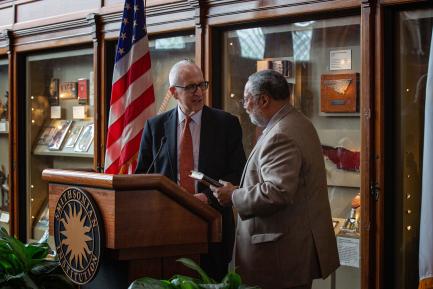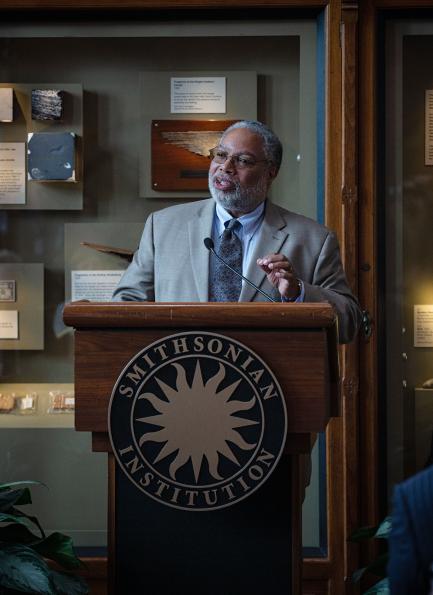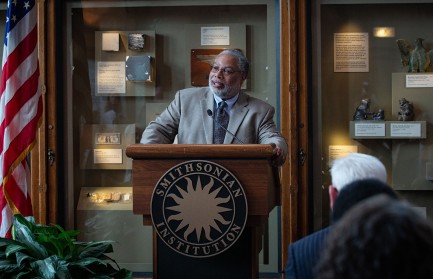
Smithsonian Regents Name Lonnie Bunch 14th Smithsonian Secretary
The Smithsonian Institution’s Board of Regents announced today it elected Lonnie G. Bunch III, director of the Smithsonian’s National Museum of African American History and Culture, as the 14th Secretary of the Smithsonian, effective June 16.
Bunch is the founding director of the National Museum of African American History and Culture, which opened in September 2016. He oversees the nation’s largest and most comprehensive cultural destination devoted exclusively to exploring, documenting and showcasing the African American story and its impact on American and world history.
Bunch’s election is unprecedented for the Smithsonian: He will be the first African American to lead the Smithsonian, and the first historian elected Secretary. In addition, he will be the first museum director to ascend to Secretary in 74 years.
“Lonnie Bunch guided, from concept to completion, the complex effort to build the premier museum celebrating African American achievements,” said John G. Roberts, Jr., Smithsonian Chancellor and Chief Justice of the United States. “I look forward to working with him as we approach the Smithsonian’s 175th anniversary, to increase its relevance and role as a beloved American institution and public trust.”
Bunch, a public historian, has spent more than 35 years in the museum field, where he is regarded as one of the nation’s leading figures in the historical and museum community. He and the Board of Regents are committed to driving forward the priorities and direction of the Smithsonian’s 2022 strategic plan.
“I am humbled and honored to become the 14th Secretary of the Smithsonian Institution,” Bunch said. “I am excited to work with the Board of Regents and my colleagues throughout the Institution to build upon its legacy and to ensure that the Smithsonian will be even more relevant and more meaningful and reach more people in the future.”
The Regents’ 11-member search committee was co-led by Board Chair David Rubenstein and Board Vice Chair Steve Case.
“Lonnie is a deeply respected scholar, educator and leader,” Rubenstein said. “In looking for someone who would shepherd the Institution into the future, we wanted to find a special person with equal parts talent and passion. Fortunately, the ideal choice for our next Secretary was already an integral part of the Smithsonian family.”
“After working at the Smithsonian in various capacities over three decades, and then birthing a wildly successful startup within the Smithsonian, Lonnie has the benefit of knowing the Smithsonian intimately,” Case said. “Now Lonnie will bring his insights and passion to reimagining the Smithsonian of the future, and creating a culture of agility and innovation to expand the Institution’s impact. The Regents stand ready to support Lonnie’s vision for driving cross-institutional collaboration to create a virtual Smithsonian that can reach everybody, everywhere.”
Under Bunch’s leadership, the National Museum of African American History and Culture came to life. When he started as director in 2005, he had one staff member, no collections, no funding and no site for a museum. Driven by optimism, determination and a commitment to build “a place that would make America better,” Bunch transformed a vision into a bold reality. The museum has welcomed about 4 million visitors and compiled a collection of 40,000 objects. The museum is the first “green building” on the National Mall. He rallied donors of every level and worked with Congress to fund the museum through a public-private collaboration.
Previously, Bunch was the president of the Chicago Historical Society, one of the nation’s oldest museums of history (2001–05). There, he led a successful capital campaign to transform the Historical Society in celebration of its 150th anniversary, managed an institutional reorganization and began an unprecedented outreach initiative to diverse communities.
A prolific and widely published author, Bunch has written on topics ranging from the black military experience to the American presidency to the impact of race in the American West. He has also written extensively about diversity in museum management and the impact of funding and politics on American museums.
Bunch’s Smithsonian experience spans three museums: the National Museum of African American History and Culture, the National Museum of American History and the National Air and Space Museum.
Bunch held a number of positions at the National Museum of American History from 1989 through 2000. As the museum’s associate director for curatorial affairs from 1994 to 2000, he oversaw the curatorial and collections management staff. While assistant director for curatorial affairs (1992–94) at the museum, Bunch supervised the planning and implementation of the museum’s research and collection programs. As a supervising curator for the museum from 1989 to 1992, he oversaw several of the museum’s divisions, including Community Life and Political History.
Bunch began his Smithsonian career as an education specialist and historian at the National Air and Space Museum from 1978 to 1979.
Bunch was curator of history and program manager for the California African American Museum in Los Angeles from 1983 to 1989. While there, he organized several award-winning exhibitions, including “The Black Olympians, 1904–1950” and “Black Angelenos: The Afro-American in Los Angeles, 1850–1950.” He also produced several historical documentaries for public television.
Born and raised in the Newark, New Jersey, area, Bunch has held numerous teaching positions at universities across the country, including American University and George Washington University, both in Washington, D.C.
Bunch has served on the advisory boards of the American Association of Museums, the Association of African American Museums, the American Association for State and Local History and ICOM-US. Among his many awards, he was appointed by President George W. Bush to the Committee for the Preservation of the White House in 2002 and reappointed by President Barack Obama in 2010. In 2005, Bunch was named one of the 100 most influential museum professionals of the 20th century by the American Association of Museums.
In 2017, Bunch was elected a member of the American Academy of Arts and Sciences. That same year, he was given the President’s Award at the NAACP Image Awards, and the Greater Washington Urban League presented him with the Impact Leader Award. In 2018, the Phi Beta Kappa Society presented Bunch with the Phi Beta Kappa Award for Distinguished Service to the Humanities, and the National Education Association honored him with the Award for Distinguished Service to Education.
Bunch received his master’s (1976) and bachelor’s (1974) degrees from American University in Washington, D.C., in African American and American history. He is married to Maria Marable-Bunch, associate director for museum learning and programs at the Smithsonian’s National Museum of the American Indian.
Bunch succeeds David Skorton, a board-certified cardiologist, who is leaving the Smithsonian to become president and CEO of the Association of American Medical Colleges.
Watch today's news conference
The Search Process
In December 2018, the Smithsonian’s Board of Regents formed an 11-member committee to search for a Secretary to succeed Skorton. The committee was assisted by the executive search firm Heidrick & Struggles. Rubenstein and Case co-chaired the committee.
The Regents committee and search firm conducted meetings with key Smithsonian stakeholders and employees to solicit their views on the types of skills and experiences the next Secretary would need; they used those conversations to develop a position specification and evaluation framework. The committee conducted interviews in April and May; the full Board of Regents voted on the new Secretary May 28.
About the Board of Regents
The 17-member Board of Regents is the governing body of the Smithsonian. It consists of the Chief Justice of the United States and the Vice President of the United States, both ex officio members of the Board; three members of the Senate; three members of the House of Representatives; and nine citizen members, nominated by the Board and approved by Congress in a joint resolution signed by the President of the United States.
About the Smithsonian
The Smithsonian Institution was founded in 1846, with a generous bequest from British scientist James Smithson (1765–1829) to found at Washington an establishment for “the increase and diffusion of knowledge.” The Smithsonian is the world’s largest museum, education and research complex, with 19 museums and the National Zoological Park.
The Smithsonian’s collections document the nation’s history and heritage and represent the world’s natural and cultural diversity. The total number of objects, works of art and specimens at the Smithsonian is estimated at nearly 155 million, including more than 146 million scientific specimens and artifacts at the National Museum of Natural History.
# # #
SI-218-2019
Linda St. Thomas
202-841-2517










